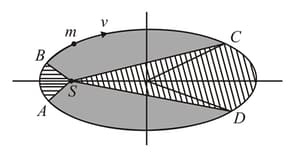Embibe Experts Solutions for Chapter: Gravitation, Exercise 3: Exercise-3
Embibe Experts Physics Solutions for Exercise - Embibe Experts Solutions for Chapter: Gravitation, Exercise 3: Exercise-3
Attempt the practice questions on Chapter 11: Gravitation, Exercise 3: Exercise-3 with hints and solutions to strengthen your understanding. Alpha Question Bank for Medical: Physics solutions are prepared by Experienced Embibe Experts.
Questions from Embibe Experts Solutions for Chapter: Gravitation, Exercise 3: Exercise-3 with Hints & Solutions
The figure shows elliptical orbit of a planet about the sun . The shaded area is twice the shaded area . If is the time for the planet to move from to and is the time to move from to , then:

The dependence of acceleration due to gravity on the distance from the centre of the earth, assumed to be a sphere of radius of uniform density is as shown in figures below. The correct figure is.
Which one of the following plots represents the variation of the gravitational field on a particle with distance due to a thin spherical shell of radius ? ( is measured from the centre of the spherical shell)
Starting from the centre of the earth having radius , the variation of (acceleration due to gravity) is shown by
The kinetic energies of a planet in an elliptical orbit about the Sun, at positions and are and respectively. is the major axis and is perpendicular to at the position of the Sun as shown in the figure. Then

Two bodies of masses and Are placed at a distance . The gravitational potential at a point on the line joining them where the gravitational field is zero is.
From a solid sphere of mass and radius , a spherical portion of radius is removed, as shown in the figure. Taking gravitational potential at , the potential at the centre of the cavity thus formed is:( gravitational constant)

A straight rod of length extends from to . The gravitational force it exerts on a point mass at , if the mass per unit length of the rod is , is given by
